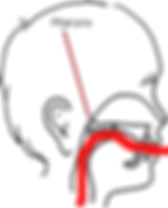Karen Levin, Ph.D Speech Therapist, Johannesburg
.jpg)

This is an animal friendly practice. People who are allergic to animals OR who do not like to be around animals are unfortunately not able to attend this practice! Apologies to those who are excluded.
Contact Us:
083 264 1697
dr.karen.levin@gmail.com
25 Zonda Avenue,
Victory Park,
Johannesburg 2195
South Africa
Karen Levin, PhD
Speech-Language Therapist and Audiologist
Johannesburg, South Africa
This is an animal-friendly practice. I cannot acccomodate those who do not want to be in the presence of animals or who are allergic. Apologies to those who are excluded.
How speech is produced
Think and talk
I have a idea that I desire to speak. I select my words and sentences. I select the sounds that are needed to make those words. I select the sequence in which those sounds, words, and sentences are to be produced. I select how loudly I need to speak, and how fast (e.g. there's a difference in how I talk to my friend, shout at someone, whisper to tell a secret, slowly to my client who cannot understand me, quickly to report an accident.... ). Then I breathe in - but not in the same way as I breathe for living because 'speech breathing' is much more complex. Air leaves the lungs, travels through the bronchi, into the windpipe, through the larynx, into the throat, into the nose or mouth. On its way out, many, many processes influence that forward flow of air.
The four processes that speech therapists address are:
-
Respiration
-
Phonation (or voicing)
-
Resonance (or velo-pharyngeal control)
-
Articulation

Respiration.
Ordinary breathing,is not the same as speech breathing. We don't think about it - we breathe in about 12 times per minute, every minute of every day. When we increase our activity, we breathe even more, so some people estimate that we can breathe in and out up to 20 000 times per day.
Speech breathing is different. When we speak, we inhale as much as we can to be comfortable, and then we have to exhale the air in tiny, very controlled amounts. We need control of our lungs as well as control of the chest. So breathing for speaking depends on good development and control of the structures and muscles used for speaking.
Speech breathing is also related to our message - what we want to say will dictate the control of air out of the lungs for speaking. The amount of air that we need to exhale while speaking depends on how many words we want to say, as well as our phrasing and pausing. In addition, the amount, speed and force of the air we exhale is also influenced by HOW we wish to speak, such as if we want to whisper, shout, speak loudly, speak softly, speak slowly and so on.
Speech therapists determine whether people are able to breathe adequately for speaking and if they have adequate control over the flow of air out of the lungs.
Many health conditions affect respiration such as asthma, chronic obstructive pulmonary disease, and weakness due to disease. Respiration is less controlled when we age. Some people have inadequate development of the structures for speech breathing such as underdeveloped lungs, and others have neurological conditions that affect the control of the musculature, such as cerebral palsy.
Voice
In the larynx, a number of muscles are coordinated to stop the forward flow of air. The vocal folds come together and vibrate so that the air is made to vibrate. This is voice.
Here is a video that shows how the voice is made. A pipe with a camera and light has been inserted into the person's nose
and goes down the back of the throat all the way down to the point where the larynx can be seen.
Velopharyngeal control or resonance
Some sounds are voiced (e.g. /d/, /t/, /b/) and others are not voiced (e.g. /p/,/t/ and /k/). The voiced or voiceless air is then pushed up into the pharynx, and depending on how the sound is made, it will enter either the nose or the mouth, depending on the movement of the soft palate. If the air is required to enter the nose (e.g. for the production of the sound /m/), then the soft palate will remain down so that the air can flow to the nasopharynx and then into the nose. If the sound to be made requires the air to flow out of the mouth (e.g. for /p/, /g/,/s/), then the soft palate is raised and the pathway of air to the nose is stopped. These images, illustrate the movement of the soft palate
Images adapted from http://www.seattlechildrens.org/medical-conditions/chromosomal-genetic-conditions/vpi/


Articulation
The air flowing out of the nose or mouth is then articulated. In other words, it is shaped and changed so that the vibrations of the air sound like the speech sounds we want to produce. The tongue moves up and down, forwards and backwards, and changes its cup shape depending on which vowels (a,e,i,o,u in all their variations) we wish to make. The cheeks, tongue, lips, pharynx and soft palate move to create the consonants. For example, the tongue tip moves up to the palate to stop the air and produce /t/. The tongue root moves backwards to touch the palate and pharynx to stop the air and to produce /k/.
